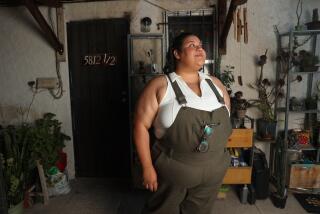Dormitory Debts Soar to $2.8 Million : Cal State Northridge: Poor record-keeping allowed hundreds of students to live rent-free in university housing.
- Share via
Poor management of dormitories and apartments operated by Cal State Northridge has allowed hundreds of students over the past two years to skip out on about $2.8 million in unpaid rents, by far the worst record among the 20 campuses in the California State University system.
About $1 million of the back rents has been recovered. But the university’s record-keeping was so bad that last fall some students were allowed back into the dormitories even though they paid no rent the previous year.
Disclosure of the losses comes as school officials consider cutting as many as 600 fall classes because of statewide budget shortages.
“The assumption among students was you could live here without paying,” said Jerome Green, who was appointed acting director of campus housing in February.
That belief apparently was not far from the truth.
Campus officials say one department received housing payments while another kept track of how much was owed. Richard T. Wells, CSUN associate vice president of business affairs, said the two departments operated separate computer accounting systems that required employees to manually match up the information, a system that turned out to be highly inefficient.
As a result, many students could ignore their housing bills and the university would not find out until months later or until they moved out at the end of the school year.
CSUN students at the end of the 1989-90 school year owed $1.4 million in back rents, campus records show. The year before, about $500,000 was owed.
During this year’s fall semester, students racked up nearly $2 million in unpaid rent, CSUN officials said. Ironically, some of that debt came from students whose contracts required them to pay for the full year in advance.
By comparison, Cal Poly San Luis Obispo Associate Housing Director Stephan Lamb said, “We have a problem with one student and non-payment.” School dormitories there accommodate about 2,800 residents.
CSUN officials are scrambling to streamline their computerized housing accounting system as another 900 or so new bed spaces in dormitories near completion. By fall, CSUN will operate the largest number of dormitory facilities of any school in the 20-campus Cal State system, with enough beds to accommodate about 3,000 of its 30,000 students.
The newest housing, called University Park, has been built over the past three years and cost between $30 million and $35 million.
Back rents owed for CSUN housing at the end of June last year accounted for about 45% of all the money owed for housing among colleges in the Cal State system, records show. At the end of the 1987-88 school year, CSUN’s share of money owed was about 2% of the system total.
George Pardon, financial management specialist for the CSU chancellor’s office, said the sharp growth in uncollected rents was first noticed by auditors a year ago. Although greater controls over rents have since been put into place, Pardon estimates that CSUN will have to borrow about $300,000 to cover operating expenses for dormitory housing this year. Under normal circumstances, Cal State campuses break even on student housing.
“There have been no significant problems at the other campuses,” Pardon said.
CSUN administrators say they are not sure how the school’s billing and collection system broke down. After auditors reported the trouble, CSUN administrators said changes were ordered in the accounting of dormitory housing. But apparently they were not completed when school started in the fall.
Housing director Green said the rapid growth in the number of students housed in CSUN dormitories since 1987 caught the school unprepared. Previously, only about 500 students lived in campus housing. This year, the school had room for more than 2,000 students.
Green’s boss, Edmund T. Peckham, vice president of student affairs and dean of students, said there is no one person responsible for the school’s failure to keep track of the unpaid rents.
“There was not the extent of coordination that I wish in retrospect there had been to ensure prompt collection of all obligations,” Peckham said.
Peckham said Diana Gruendler, who resigned as housing director in December, failed to notify campus officials of the size of the rent problem.
But it was reportedly common knowledge among workers in the school’s housing department. A former employee there said she and co-workers during the 1988-89 school year became aware that hundreds of thousands of dollars in rents were being lost because of poor record-keeping.
“Kids would call and ask, ‘How much do I owe?’ and I would have to ask, ‘How much have you paid?’ ” said Carole Breyde, who worked as a clerk in the housing office from July, 1988, to September, 1989. “Accountability was confusing at best.”
In addition, students learned that if they indicated they were financial aid recipients, they were allowed to move in with only a small down payment. Then, when the bills came due, many of those students simply ignored them.
Beginning in the fall, housing officials will begin verifying whether or not students are receiving financial aid, CSUN officials said.
Regardless of the cause of the trouble, CSUN is under pressure to straighten out its accounting because continued losses may hurt the ability of the CSU system to finance future dormitory construction.
Elliot Mininberg, CSUN’s vice president of administration, said a collection agency will be hired to collect an estimated $750,000 in unpaid rents from previous years. He said he is hoping to collect about $500,000 of that debt and write off the rest.
“We will be going after the money,” Mininberg said. “I don’t think taxpayers want to lose that.”
But, he added, “some of the kids are going to be hard to find.”
The stepped-up collection effort, as well as a new eviction procedure, are intended to let students know the free ride is over, Mininberg said.
Green said he has spoken to hundreds of students since taking over the housing department this winter and persuaded many to pay up.
“I tell students, ‘Let’s talk, but you have to pay your debt even if it takes nine months,’ ” Green said.
The university can freeze student records and bar them from registering for classes if they fail to pay their dormitory rent, campus officials said.
Reaction in the dormitories was generally supportive of the university’s attempts to collect back rents, as reflected in an informal sampling. “I think the university should really go after them to pay those bills,” said Marianne Mandell of Huntington Beach, who was helping her daughter, Lisa, move out of the student dormitories for the summer. “We paid in good faith and everyone else certainly should.”
Lisa Mandell, a psychology student, agreed. “It’s really unfair,” she said.
But another dormitory resident, Judy Charwock, a graduate student in film from Rhode Island, said that she had been sent several notices to pay her rent, when in fact she had paid it.
“It’s just a mess,” she said, explaining that she had paid in two installments. “I had to find my canceled checks and explain, and the people in the office still got it wrong.”
Erik Keelman, a junior economics student from Dana Point, said that some students may have felt they weren’t getting their money’s worth.
“The windows don’t open in some of the dorms, the elevators are shaky. Everyone is always complaining about things. You can’t blame some of them for not paying,” he said.
Getting students to pay their rents may be only a small part of CSUN’s problem. The dormitories are operating at about 85% occupancy, short of the 95% needed to break even, campus officials said. By comparison, the dormitories at Cal Poly San Luis Obispo operate at about 98%, officials there said.
The CSUN housing ranges in price from $405 a month to share a room with an attached kitchen to about $522 a month for a private room in an apartment. Those prices, which do not include meals, are no bargain in the San Fernando Valley housing market, which is awash with available apartments.
For next year, Green hopes occupancy will climb to between 92% and 94%.
To achieve that, the housing office plans to attract more residents by expanding dormitory programs, such as tutoring, and increasing the number of social activities, he said.
At the same time, Green said, the university will keep close tabs on payments and evict students who do not pay. He concedes that may discourage many of the current residents from returning next year.
“Some people don’t want to live where there are rules and regulations,” he said.
Times staff writer Carol McGraw contributed to this story.
CSUN Dormitory Debt
Percentage of total $3.2-million housing debt owed in the 20-campus Cal State system at the end of the 1989-90 school year CSUN: 44.94% Fresno: 16.59% Other*: 12.82% Sacramento: 6.13% Long Beach: 5.43% Los Angeles: 4.93% Pomona: 4.81% San Luis Obispo: 4.35% * 13 remaining campuses, each less than 3%
Unpaid dormitory rent at Cal State Northridge at end of school year Year: Total Owed 1987-88: $86,795 1988-89: $501,373 1989-90: $1,401,120
More to Read
Sign up for Essential California
The most important California stories and recommendations in your inbox every morning.
You may occasionally receive promotional content from the Los Angeles Times.










